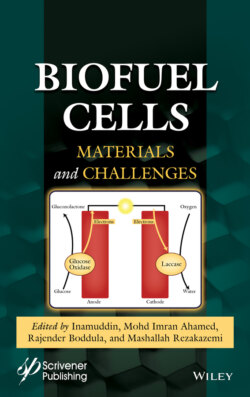Читать книгу Biofuel Cells - Группа авторов - Страница 22
1.4.4 Metal–Organic Framework (MOF)-Based Carbonaceous Materials as Bioelectrodes for BFCs
ОглавлениеMOFs have advantages over typical carbon supports such as tailorable properties from the preparation method, large specific surface area (SSA), high porosity and easy modification with metal atoms and heteroatoms like nitrogen [116]. Porous carbon supports obtained through calcination of MOFs have attracted attention in the energy conversion area because the high specific surface area and ordered porous structure enable a convenient path for electron transfer [117]. In MFCs, these materials are highly used to improve the oxygen reduction, and there are several works focused on this topic as was highlighted in a recent review [118]. Wang et al. [117] obtained a hollow material based on Cu/Co/N with a BET surface area of 286 m2 g−1 and a half-wave potential shifted to more positive values in contrast with a benchmarked Pt/C electrocatalyst. This improvement was attributed to the electron properties of this MOF-derived material, which displayed an OCV of 0.68 V, and a maximum power density of 1,008 mW cm−2. This performance is comparable to that obtained with N-doped materials [110–114]. Zhong et al. [119] obtained a MOF-derived electrocatalyst for oxygen reduction reaction in MFCs using Zr-based MOF UiO66-NH2 and incorporating Co–Nx active components. This electrocatalyst had a BET surface area of 279 m2 g−1 and, similarly to the Cu/Co/N, this material had a more positive half-wave potential (35 mV) than the benchmarked Pt/C. The cell performance evaluation indicated that this material achieved an OCV of 0.39 V and a maximum power density of 299.62 mW cm−2, which was slightly lower to that obtained by Pt/C (312.59 mW cm−2). Wang et al. [120] used the isoreticular metal organic framework-3 (IRMOF-3) modified with g-C3N4 nanosheets to obtain a N-doped carbon material with a BET surface area of 686.41 m2 g−1. This material displayed superior activity in half-cell and full-cell experiments, the half-wave potential and current density were superior to those obtained for benchmarked Pt/C (0.89 vs. 0.79 V and 6.35 vs. 5.51 mA cm−2, respectively). Additionally, the maximum power density was 1,402.8 mW cm−3, which was 110 mW cm−3 higher to that obtained by Pt/C. Xe et al. [121] reported an electrocatalyst for oxygen reduction reaction in MFCs based on zeolitic imidazolate framework (ZIF-8), this new material displayed a BET surface area of 1,416.19 m2 g−1, which is larger to that previously mentioned. Consequently, the maximum power density was 2,103.4 mW cm−2, which also at least 3 and 3 times higher to that reported in the previous works. The ZIF-8 was then modified with polypyrrole to fabricate a polyhedral porous carbon embedded N-doped carbon networks (PPC/NC) [122]. This material presented a surface area of 342.3 m2 g−1, but the improvement in the electron transfer allowed achieving power densities of 2,401 mW cm−2, which was 3.3 times higher than the control, and between 1.7 and 8 times higher to that obtained in the previous works herein discussed. Finally, Luo et al. [123] modified the ZIF-8 with FeS to dope the resulting carbon material with Fe, N, and S heteroatoms. This modified material had a BET surface area of 598 m2 g−1, and the presence of heteroatoms improved the power density of a MFC, displaying a maximum value of 1,196 mW cm−2 with an OCV of 0.71 V.
On the other hand, the use of MOF for the preparation of enzymatic electrodes is limited. Li et al. [124] developed an enzymatic BFC encapsulating laccase in the ZIF-8 MOF. This electrode array was combined with bacterial cellulose and carboxylated carbon nanotubes achieving OCVs close to 0.3 V, and a maximum current density of 3.68 W m−3. Zhang et al. [125] reported the use of the IRMOF-8 impregnated in carbon nanotubes to develop a porous carbon intercalated by multi-walled carbon nanotubes (PC/MWCNTs) as anode for the immobilization of alcohol dehydrogenase. This material had a BET surface area of 1,166 m2 g-1, while the electrochemical evaluation in half-cell tests demonstrated the superior activity for alcohol oxidation than PC and MWCNTs alone. Nonetheless, full-cell tests were not presented.
